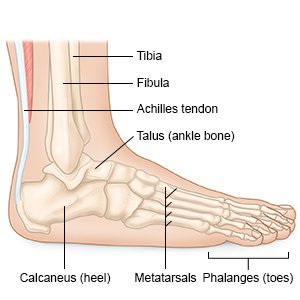Heel Spur
Medically reviewed by Drugs.com. Last updated on Apr 2, 2024.
What is a heel spur?
A heel spur develops when calcium builds up on the underside of your heel bone. Heel spurs can be caused by inflammation or strains on your foot muscles and ligaments.
 |
What are the signs and symptoms of a heel spur?
Heel spurs are often painless. If the tissue around your heel swells, you may have any of the following:
- Pain on the bottom of your foot near your heel
- Pain that is worse right after you get out of bed or after a long period of rest
- Pain with activity
- Heel swelling or warmth
- A stabbing pain under your foot, often when you stand after you sit or lie for a long time
What increases my risk for a heel spur?
- Anything that puts pressure on your heel, such as pregnancy or obesity
- High-impact activities, such as when you run or play a sport such as tennis or basketball
- A sudden increase in the intensity of an activity
- Shoes that do not support your feet, such as shoes that are worn out or are too big
- A medical condition that causes inflammation, such as rheumatoid arthritis
How is heel spur diagnosed?
Your healthcare provider will examine your foot and ask about your activities. Your provider may check the movement of your foot and ankle. You may need an x-ray to check for a fracture or other problem.
How is heel spur treated?
- Medicines may be given to decrease swelling and pain:
- NSAIDs , such as ibuprofen, help decrease swelling, pain, and fever. This medicine is available with or without a doctor's order. NSAIDs can cause stomach bleeding or kidney problems in certain people. If you take blood thinner medicine, always ask your healthcare provider if NSAIDs are safe for you. Always read the medicine label and follow directions.
- Acetaminophen decreases pain and fever. It is available without a doctor's order. Ask how much to take and how often to take it. Follow directions. Read the labels of all other medicines you are using to see if they also contain acetaminophen, or ask your doctor or pharmacist. Acetaminophen can cause liver damage if not taken correctly.
- A steroid injection into the heel may help relieve pain and swelling. This is usually only recommended if other treatment does not work.
- Devices may be used to decrease stress on the muscles and tendons in your feet. Your healthcare provider may recommend you wear a shoe insert, such as a pad or heel cup. Your provider may also show you how to tape your foot.
- Physical therapy may help relieve your symptoms. A physical therapist teaches you exercises to help improve movement and strength, and to decrease pain.
Treatment options
The following list of medications are related to or used in the treatment of this condition.
How can I manage a heel spur?
- Rest your injured foot. You may need to avoid putting any weight on your leg for at least 48 hours. Return to normal activities as directed.
- Apply ice or heat to your heel. Ice and heat help relieve pain. Ice also helps decrease swelling. For ice, use an ice pack or put crushed ice in a plastic bag. Cover the bag with a towel before you apply it to your skin. Apply ice for 15 to 20 minutes as often as directed. For heat, use a heat pack or a heating pad on a low setting. Apply heat for 20 minutes as often as recommended. Your healthcare provider may recommend that you alternate applying ice and heat.
- Stretch before you get out of bed and as directed. This loosens your muscles and tendons in your legs and feet. Ask your healthcare provider which stretches you should do and how often to do them.
- Maintain a healthy weight. This will help decrease stress on your feet. Ask your healthcare provider what a healthy weight is for you. Ask your provider to help you create a weight loss plan, if needed.
- Do low-impact exercises. Low-impact exercises decrease stress on your heel. Examples include swimming or bicycling. Start new activities slowly. Increase the intensity and time gradually.
- Wear shoes that fit well and support your arch. Replace your shoes before the padding or shock absorption wears out. Do not walk or stand in bare feet or sandals for long periods of time.
When should I call my doctor?
- Your pain or swelling suddenly increases.
- You develop knee, hip, or back pain.
- You have questions or concerns about your condition or care.
Care Agreement
You have the right to help plan your care. Learn about your health condition and how it may be treated. Discuss treatment options with your healthcare providers to decide what care you want to receive. You always have the right to refuse treatment. The above information is an educational aid only. It is not intended as medical advice for individual conditions or treatments. Talk to your doctor, nurse or pharmacist before following any medical regimen to see if it is safe and effective for you.© Copyright Merative 2024 Information is for End User's use only and may not be sold, redistributed or otherwise used for commercial purposes.
Learn more about Heel Spur
Treatment options
Symptoms and treatments
Further information
Always consult your healthcare provider to ensure the information displayed on this page applies to your personal circumstances.
